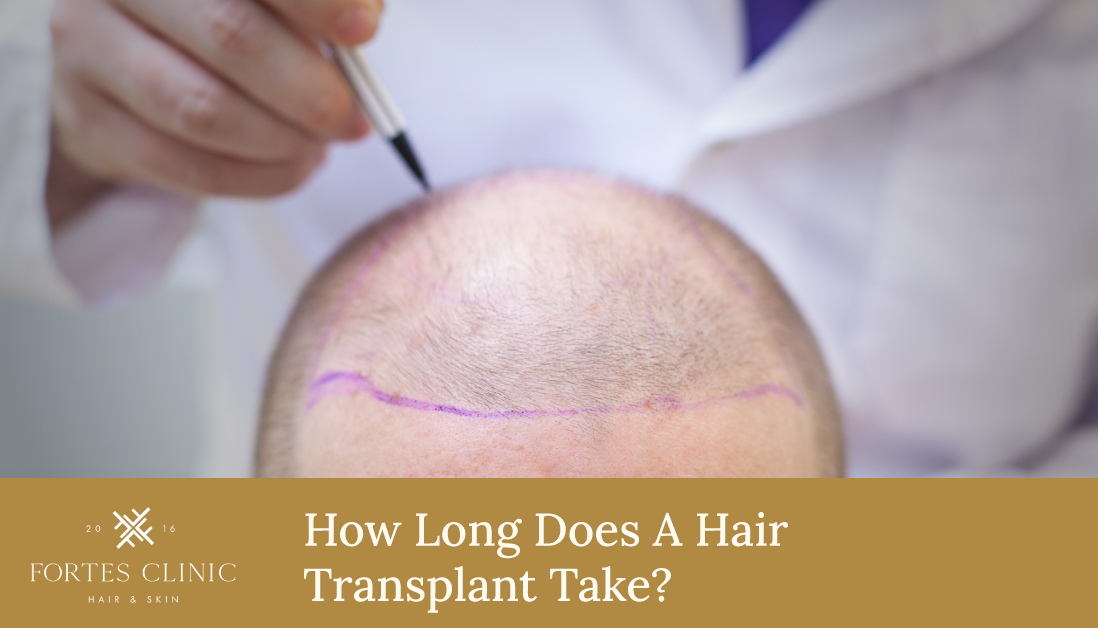Introduction: How Long Does A Hair Transplant Take?
Hair transplants, a beacon of hope for those grappling with hair loss, have revolutionised the field of hair restoration. The procedure, blending medical expertise with aesthetic finesse, raises a crucial question among potential candidates: “How long does a hair transplant take?” This article aims to unravel the complexities of hair transplant procedures, offering a detailed insight into the time commitment involved.
Understanding Hair Transplantation
What is a Hair Transplant?
At its core, a hair transplant is a surgical technique where hair follicles are moved from a densely-haired region, or ‘donor site’, to a balding or thinning area, known as the ‘recipient site’. This procedure is predominantly used to address male pattern baldness, a common form of hair loss in men.
Types of Hair Transplant Techniques
Follicular Unit Transplantation (FUT)
FUT, also known as the strip method, involves excising a strip of scalp from the back of the head, from which individual follicular units are meticulously separated and prepared for transplantation. This technique is renowned for its efficiency in covering large bald areas.
Follicular Unit Extraction (FUE)
FUE stands as a more recent advancement where individual hair follicles are extracted directly from the scalp using precise micro-punches. This method is celebrated for its minimal scarring and is preferable for those who favour short hairstyles.
Advanced Techniques and Innovations
The field of hair transplantation is continually evolving, with newer techniques like Direct Hair Implantation (DHI) using specialised pens for implantation, and robotic-assisted transplants enhancing precision and reducing recovery time.
Factors Influencing the Duration of a Hair Transplant
Extent of Hair Loss and Area Coverage
The area needing coverage and the severity of hair loss significantly dictate the duration of the transplant. Larger areas naturally require more time for follicle implantation.
Technique Used: FUT vs. FUE
The choice between FUT and FUE impacts the procedure’s length. FUE, involving individual follicle extraction, generally demands more time compared to the strip method of FUT.
Skill and Experience of the Surgical Team
A skilled surgical team, led by an experienced surgeon, can significantly influence the efficiency and speed of the procedure. Expertise in the field directly correlates with reduced procedure time and enhanced outcomes.
Individual Healing and Health Conditions
Factors like individual healing rates, scalp elasticity, and overall health can also influence the duration of the surgery. These elements are assessed during pre-operative consultations to tailor the procedure accordingly.
The Hair Transplant Procedure: A Step-by-Step Guide
Pre-Procedure Consultations and Preparations
The journey begins with in-depth consultations where the surgeon evaluates the patient’s hair density, scalp laxity, and discusses desired outcomes. Preparatory steps might include blood tests and guidelines on medication and lifestyle changes pre-surgery.
The Day of the Surgery: What to Expect
On the day of the surgery, the patient undergoes local anaesthesia. The process starts with the preparation of the donor area, followed by the extraction and transplantation of hair follicles. The duration hinges on the number of grafts required.
Post-Procedure: Recovery and Follow-up
The post-procedure phase is critical for ensuring the success of the transplant. It involves managing any discomfort, adhering to post-operative care instructions, and attending follow-up visits for monitoring progress.
How Long Does the Hair Transplant Procedure Take?
Average Duration of FUT and FUE Hair Transplant Procedures
Typically, an FUT procedure can span 4-8 hours, while FUE might extend up to 12 hours, especially in cases requiring a large number of grafts.
Factors Contributing to Variations in Duration
Differences in procedure length arise from the extent of balding, the chosen technique, and individual patient factors like hair texture and graft survival rates.
Post-Procedure Care and Recovery Time
Immediate Post-Procedure Care
Patients may experience swelling, redness, and mild discomfort, which are manageable with prescribed medications. These symptoms typically subside within a few days.
Long-Term Recovery and Hair Growth Timeline
Initially, transplanted hair will shed, which is a normal part of the process. New hair growth starts to become noticeable within 3-4 months. The complete outcome of the transplant is usually visible after 8-12 months.
Tips for a Smooth Recovery
Avoiding strenuous activities, adhering to a nutritious diet, and following the surgeon’s care instructions are pivotal for a smooth recovery and optimal hair growth.
Summary of Key Points
Understanding the time frame for a hair transplant is essential for setting realistic expectations. With a reputable clinic like Fortes Clinic in London, patients are assured of an experience marked by expert care, advanced techniques, and a commitment to achieving desired results.
Frequently Asked Questions (FAQs)
How Safe is a Hair Transplant?
Hair transplants are generally very safe when performed by qualified and experienced surgeons. Complications are rare, but as with any surgical procedure, there is a minimal risk of infection or scarring. Our clinic follows stringent protocols to ensure the highest safety standards.
Will the Results Look Natural?
Absolutely. One of the primary goals of a hair transplant is to achieve a natural-looking result. Our experienced surgeons ensure that the hairline is designed and the grafts are placed in a way that mimics natural hair growth patterns.
How Long Will the Results Last?
Hair transplant results are typically permanent. The transplanted hair follicles are genetically resistant to balding, which means they should continue to grow for a lifetime. However, it’s important to note that a hair transplant does not stop non-transplanted hair from continuing to thin or recede.
Is the Hair Transplant Procedure Painful?
Most patients experience minimal discomfort during the procedure. Local anaesthesia is used to numb the scalp, and patients can usually relax, listen to music, or watch movies during the procedure. Post-operative pain is generally mild and can be managed with over-the-counter pain relievers.
How Long is the Recovery Period?
Recovery times can vary, but most patients feel well enough to return to work and most normal activities within a week. It’s important to follow post-operative care instructions to ensure a smooth recovery.
Contact our friendly team today to begin your hair restoration journey.



